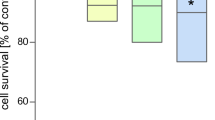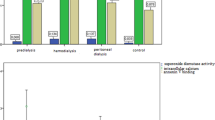Abstract
Chronic renal failure (CRF) is usually accompanied by abnormalities of both humoral and cellular immune response. The aim of the study was to investigate the influence of N-acetyl-cysteine (NAC) on intracellular oxidative stress and apoptosis rate of T lymphocytes in children with CRF. Twenty-two children (aged 4–16, mean 7.4) with CRF treated with dialysis were enrolled in the study. Intracellular reactive oxygen species (ROS) production was quantified by mean rhodamine 123 (RHO) fluorescence intensity with flow cytometry. Annexin V FITC was used for identifying apoptotic cells. Mean fluorescence intensity (MFI), which reflected intracellular oxidative stress in T lymphocytes, was increased in patients with CRF compared with the controls (CD3+: 31.58±11.58 vs 22.55±4.97, p =0.043; CD3+CD4+: 32.50±8.59 vs 27.75±12.76, NS; CD3+CD8+: 32.10±11.85 vs 20.77±4.89, p =0.012). Apoptotic T lymphocytes occurred more frequently in patients with CRF treated with hemodialysis (HD) (11.36±6.96%) than in the controls (6.14%±3.36%; p =0.025). After 24 h incubation with NAC MFI and apoptosis rate decreased significantly in all subpopulations of lymphocytes. NAC, as a strong antioxidant, has a favorable effect on intracellular oxidative stress and apoptosis rate of T lymphocytes in patients with CRF. A decreased apoptosis rate may have positive effect on functional abnormalities of T cells already found in patients with CRF.






Similar content being viewed by others
References
Chatenoud L, Herbelin A, Beaurain G, Descamps-Latscha B (1990) Immune deficiency of the uremic patients. Adv Nephrol Necker Hosp 19:259–274
Galle J (2001) Oxidative stress in chronic renal failure. Nephrol Dial Transplant 16:2135–2137
Descamps-Latscha B, Drueke T, Witko-Sarsat V (2001) Dialysis-induced oxidative stress: biological aspects, clinical consequences, and therapy. Semin Dial 14:193–199
Touyz RM (2004) Reactive oxygen species, vascular oxidative stress, and redox signaling in hypertension: what is the clinical significance? Hypertension 44:248–252
Usberti M, Gerardi GM, Gazzottia RM, Benedini S, Archetti S, Sugherini L, Valentini M, Tira P, Bufano G, Albertini A, Di Lorenzo D (2002) Oxidative stress and cardiovascular disease in dialyzed patients. Nephron 91:25–33
Mantovani G, Maccio A, Melis G, Mura L, Massa E, Mudu MC (2000) Restoration of functional defects in peripheral blood mononuclear cells isolated from cancer patients by thiol antioxidants alpha-lipoic acid and N-acetyl cysteine. Int J Cancer 86:842–847
Kashihara N, Sugiyama H, Makino H (1999) Mechanisms for induction of apoptosis and glomerular disease. Nephrol Dial Transplant 14 [Suppl] 1:52–54
Nahar N, Shah H, Siu J, Colvin R, Bhaskaran M, Ranjan R, Wagner JD, Singhal PC (2001). Dialysis membrane-induced neutrophil apoptosis is mediated through free radicals. Clin Nephrol 56:52–59
Bhaskaran M, Ranjan R, Shah H, Siu J, Colvin R, Radhakrishnan, N, Reddy K, Franki N, Wagner JD, Singhal PC (2002) Lymphopenia in dialysis patients: a preliminary study indicating a possible role of apoptosis. Clin Nephrol 57: 221–229
Van der Veen RC, Dietlin TA, Karapetian A, Holland SM, Hofman FM (2004) Extra-cellular superoxide promotes T cell expansion through inactivation of nitric oxide. J Neuroimmunol 153:183–189
Descamps-Latscha B, Jungers, P (1996) New molecular aspects of chronic uraemia and dialysis related immunocompetent cell activation. Nephrol Dial Transplant 11: S121–S124
Cavdar C, Sayan M, Sifil A, Artuk C, Yilmaz N, Bahar H, Camsari T (2003) The comparison of antibody response to influenza vaccination in continuous ambulatory peritoneal dialysis, hemodialysis and renal transplantation patients. Scand J Urol Nephrol 37:71–76
Pesanti EL (2001) Immunologic defects and vaccination in patients with chronic renal failure. Infect Dis Clin North Am 15:813–832
Vlassopoulos D (2003) Recombinant hepatitis B vaccination in renal failure patients. Curr Pharm Biotechnol 4:141–151
Bloembergen WE, Port FK (1996) Epidemiological perspective on infections in chronic dialysis patients. Adv Ren Replace Ther 3:201–207
Cohen G, Haag-Weber M, Horl WH (1997) Immune dysfunction in uremia. Kidney Int 52: S79–S82
Libetta C, Rampino T, Dal-Canton A (2001) Polarization of T-helper lymphocytes toward the Th2 phenotype in uremic patients. Am J Kidney Dis 38:286–295
Descamps-Latscha B, Chatenoud L (1996) T cells and B cells in chronic renal failure. Semin Nephrol 16:183–191
Senatorec, M, Cecerea P, Colomboa P, Costantinia L, Filibertia O, Piccinia G, Peonaa C, Buemib M, Nicolettic A, Rizzuto, G (2002) Immune dysfunction and cytokine production in hemodialysis: could they be lessened by vitamin E-coated dialyzer membrane? Nephron 92:758–762
Girndt M, Sester M, Sester U, Kaul H, Kohler H (2001) Defective expression of B7-2 (CD86) on monocytes of dialysis patients correlates to the uremia-associated immune defect. Kidney Int 59:1382–1389
Vermes I, Haanen C, Steffens-Nakken H, Reutelingsperger C (1995) A novel assay for apoptosis. Flow cytometry detection of phosphatidylserine expression on early apoptotic cells using fluorescein labelled Annexin V. J Immunol Methods 184:39–51
Koopman G, Reutelingsperger C, Kuijten G, Keehnen R, Pals S, Oers M (1994). Annexin V for flow cytometric detection of phosphatidylserine expression on B cells undergoing apoptosis. Blood 84:1415–1420
de Zwart LL, Meerman JH, Commandeur JN, Vermeulen NP (1999) Biomarkers of free radical damage applications in experimental animals and in humans. Free Radic Biol Med 26:202–226
Hershko C, Link G, Cabantchik I (1998) Pathophysiology of iron overload. Ann N Y Acad Sci 850:191–201
Vowells SJ, Sekhsaria S, Malech HL, Shalit M, Fleisher TA (1995) Flow cytometric analysis of the granulocyte respiratory burst: a comparison study of fluorescent probes. J Immunol Methods 178:89–97
Keston AS, Brandt R (1965) The fluorometric analysis of ultramicro-quantities of hydrogen peroxide. Anal Biochem 11:1–5
Brandt R, Keston AS (1965) Synthesis of diacetyldichlorofluorescin: a stable reagent for fluorometric analysis. Anal Biochem 11: 6– 9
Bass DA, Parce JW, Dechatelet LR, Szejda P, Seeds MC, Thomas M (1984) Flow cytometric studies of oxidative product formation by neutrophils: a graded response to membrane stimulation. J Immunol 130:1910–1917
Ostrovidov S, Franck P, Joseph D, Martarello L, Kirsch G, Belleville F, Nabet P, Dousset B (2000) Screening of new antioxidant molecules using flow cytometry. J Med Chem 43:1762–1769
Crow JP (1997) Dichlorodihydrofluorescein and dihydrorhodamine 123 are sensitive indicators of peroxynitrite in vitro: implications for intracellular measurement of reactive nitrogen and oxygen species. Nitric Oxide 1:145– 157
Handelman GJ (2000). Evaluation of oxidant stress in dialysis patients. Blood Purif 18:343–349
Clermont G, Lecour S, Cabanne JF, Motte G, Guilland JC, Chevet D, Rochette L (2001) Vitamin E-coated dialyzer reduces oxidative stress in hemodialysis patients. Free Radic Biol Med 31:233–241
Su B, Mitra S, Gregg H, Flavahan S, Chotani MA, Clark KR, Goldschmidt-Clermont PJ, Flavahan N.A (2001). Redox regulation of vascular smooth muscle cell differentiation. Circ Res 89:39–46
Neal R, Matthews RH, Lutz P, Ercal N (2003) Antioxidant role of N-acetyl cysteine isomers following high-dose irradiation. Free Radic Biol Med 34:689–695
Gibson XA, Shartava A, McIntyre J, Shalit M, Fleisher TA (1998) The efficacy of reducing agents or antioxidants in blocking the formation of dense cells and irreversibly sickled cells in vitro. Blood 91:4373–4378
Carracedo J, Ramirez R, Madueno JA, Soriano S, Rodriguez-Benot A, Rodriguez M, Martin-Malo A, Aljama, P (2002) Cell apoptosis and hemodialysis-induced inflammation. Kidney Int Suppl 80:89–93
Hack V, Breitkreutz R, Kinscherf R, Rohrer H, Bartsch P, Taut F, Benner A, Droge W (1998) The redox state as a correlate of senescence and wasting and as a target for therapeutic intervention. Blood 92:59–67
Kim MS, Lee J, Lee KM, Yang SH, Choi S, Chung SY, Kim TY, Jeong WH (2003) Involvement of hydrogen peroxide in mistletoe lectin-II-induced apoptosis of myeloleukemic U937 cells. Life Sci 73:1231–1243
Quadrilatero J, Hoffman-Goetz L (2004) N-Acetyl-L-cysteine prevents exercise-induced intestinal lymphocyte apoptosis by maintaining intracellular glutathione levels and reducing mitochondrial membrane depolarization. Biochem Biophys Res Commun 319:894–901
Acknowledgments
This work was supported in part by a research grant from the Poznan University of Medical Sciences, Poland (501-1-05-27). We would like to thank Ms. Renea M. Florschutz for her linguistic help in the preparation of the manuscript
Author information
Authors and Affiliations
Corresponding author
Rights and permissions
About this article
Cite this article
Zachwieja, J., Zaniew, M., Bobkowski, W. et al. Beneficial in vitro effect of N-acetyl-cysteine on oxidative stress and apoptosis. Pediatr Nephrol 20, 725–731 (2005). https://doi.org/10.1007/s00467-004-1806-4
Received:
Revised:
Accepted:
Published:
Issue Date:
DOI: https://doi.org/10.1007/s00467-004-1806-4




